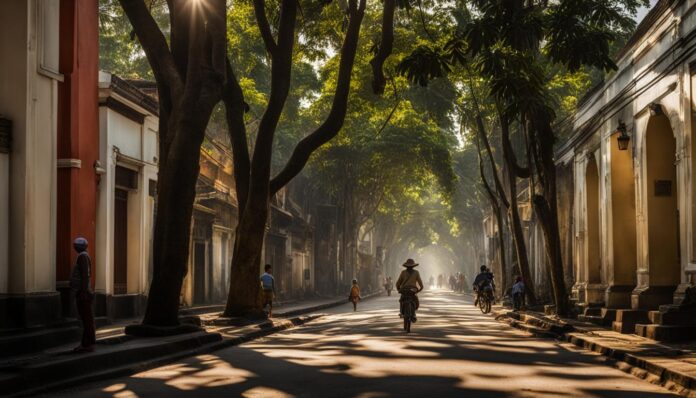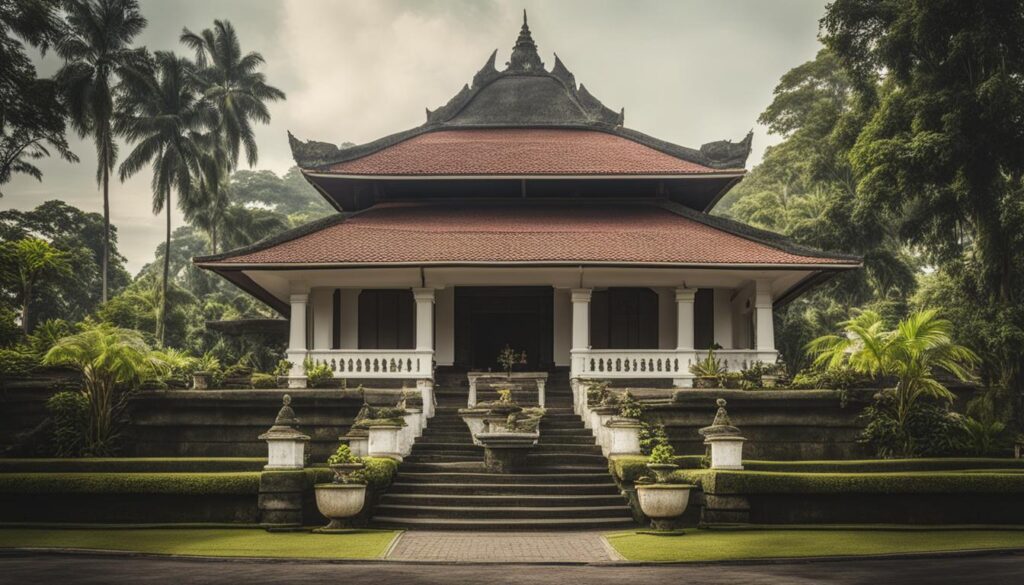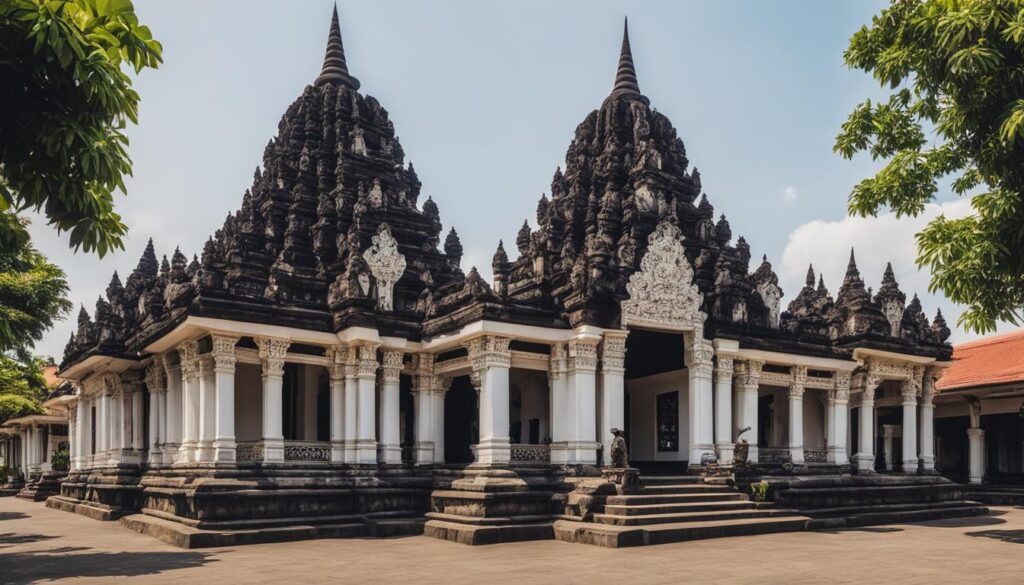If you’re looking to discover the rich history and cultural treasures of Yogyakarta, one of the best ways to do so is through Yogyakarta heritage walks. Yogyakarta is a city with a fascinating colonial past and a unique fusion of Indonesian and European architectural styles. By exploring the city on foot, you can fully immerse yourself in its colonial architecture and fascinating heritage sites.
In this section, we will delve into the importance of colonial architecture in Yogyakarta and how guided tours can enhance your experience as you discover the city’s rich cultural history through exploration.
Immerse Yourself in Indonesia’s Rich History
When it comes to cultural tourism, Yogyakarta is a real gem. The city is steeped in history, providing visitors with a unique glimpse into Indonesia’s rich past. If you want to delve deeper into Yogyakarta’s colonial heritage, booking a guided tour is highly recommended. Not only will you learn about the historical significance of the city’s cultural landmarks and historical sites, but you will also gain a greater appreciation for the unique blend of Indonesian and colonial influences found in Yogyakarta’s architectural wonders.
If you’re not sure where to start, some popular guided tours include the Yogyakarta Heritage Walk and the Kotagede Heritage Tour. Both tours offer glimpses into the city’s past and showcase the unique architecture that makes Yogyakarta a popular destination for cultural tourism.
Some historical sites to include on your itinerary are the Sultan’s Palace, Taman Sari Water Castle, and the Fort Vredeburg Museum. Each site offers insight into Indonesia’s history and the unique cultural influences that shaped Yogyakarta into the city it is today. With a well-informed guide to lead you, you can enjoy a truly immersive cultural tourism experience.
In addition to guided tours, you can also opt to explore Yogyakarta’s cultural landmarks on your own. However, keep in mind that some attractions require a guide, so be sure to check ahead of time. Whether you opt for a guided tour or prefer to explore on your own, Yogyakarta’s cultural tourism scene is not to be missed.
Uncover Architectural Wonders of Yogyakarta
Yogyakarta’s heritage sites boast an array of architectural wonders that reflect the harmonious fusion of colonial and Indonesian influences. From elegant royal palaces to iconic religious landmarks, these sites provide a glimpse into the city’s rich past and diverse cultural heritage.
The following are some of Yogyakarta’s must-visit heritage sites renowned for their stunning architectural design:
| Heritage Site | Architectural Style |
|---|---|
| Borobudur Temple | Javanese Buddhist architecture |
| Prambanan Temple | Javanese Hindu architecture |
| Kraton Yogyakarta | Javanese palace architecture with Dutch colonial influence |
| Taman Sari Water Castle | Javanese palace architecture with Portuguese and Dutch colonial influence |
These heritage sites have been carefully preserved to maintain their original architectural splendor. A visit to these sites not only provides a cultural and historical experience but also a visual journey through the blending of architectural styles over centuries.
“The combination of Javanese, Dutch, and Portuguese architectural influences is evident in the intricate design details of these heritage sites. This confluence of cultures is what makes Yogyakarta’s architectural wonders truly unique.”
Exploring Yogyakarta’s Historical Landmarks
Yogyakarta is steeped in history, and its historical landmarks offer visitors an opportunity to explore the city’s rich past. From ancient temples to colonial-era buildings, these sites connect the modern-day city to its legacy as a cultural and political hub.
One of the must-visit historical landmarks in Yogyakarta is the Keraton (Royal Palace). Built in the 18th century, the palace showcases traditional Javanese architecture and houses a museum with artifacts and exhibits related to the city’s royal history. Another popular landmark is the Taman Sari Water Castle, a UNESCO-listed site that was once a royal garden and bathing complex.
The Vredeburg Fortress is another architectural masterpiece that transports visitors back to the days of Dutch colonial rule. Built in the 18th century as a defense fortress, it now houses a museum showcasing the city’s history of resistance to colonialism. Another noteworthy site is the Sambisari Temple, an ancient Hindu temple dating back to the 9th century.
| Historical Landmark | Description |
|---|---|
| Keraton (Royal Palace) | A royal residence showcasing traditional Javanese architecture and culture. |
| Taman Sari Water Castle | A former royal garden and bathing complex now designated as a UNESCO World Heritage site. |
| Vredeburg Fortress | A Dutch colonial fortress, now a museum dedicated to the city’s history of resistance to colonialism. |
| Sambisari Temple | An ancient Hindu temple dating back to the 9th century. |
Exploring Yogyakarta’s historical landmarks is an ideal way to gain insight into the city’s past and experience its culture. It’s a testament to Yogyakarta’s heritage and a reminder of the incredible history that underpins this vibrant city.
Tracing Indonesian Colonial History
Indonesia’s colonial history can be traced back to the 16th century when the Dutch East India Company became the dominant European power in the region. By the 19th century, the Dutch had established colonial rule over most of the Indonesian archipelago, including Yogyakarta.
The establishment of Dutch colonial rule had a significant impact on Yogyakarta’s architecture and culture. The Dutch introduced modern infrastructure and building techniques, resulting in the construction of magnificent colonial buildings and landmarks that still stand today. However, Dutch colonialism also led to a repression of traditional Javanese culture and widespread economic exploitation.
“Colonialism scars the earth with its monuments, its landmarks, and its histories – but those scars also create the landscapes and histories of colonies themselves.”
– Gyan Prakash, historian
The legacy of Dutch colonialism can still be seen in Yogyakarta’s colonial architecture and cultural practices. By delving into the city’s colonial history and heritage, you gain a deeper understanding of Indonesia’s past and present.
Join a Guided Heritage Walk in Yogyakarta
If you’re looking to truly immerse yourself in Yogyakarta’s colonial heritage, joining a guided heritage walk is a must. Not only will you have the opportunity to explore the city’s historical sites, but you’ll also gain a deeper understanding of their significance through the expertise of your local guide.
Yogyakarta heritage walks offer an engaging and educational experience, with knowledgeable guides leading you through the city’s rich history and architectural wonders. You’ll discover new insights into Yogyakarta’s colonial past and gain a greater appreciation for the unique blend of colonial and Indonesian influences.
What to expect on a guided heritage walk
Your heritage walk will begin with an introduction to the city’s colonial past, including the Dutch and Japanese occupations and their impact on Yogyakarta’s architecture and culture. From there, your guide will lead you to some of the most significant historical landmarks in the city, highlighting their unique features and historical significance.
You’ll also have the opportunity to explore Yogyakarta’s diverse architecture, from the grand colonial buildings to the traditional Indonesian houses. Your guide will provide context and insights into the architectural styles and their cultural meanings.
Overall, a guided heritage walk is an immersive and illuminating experience that will leave you with a deeper understanding and appreciation of Yogyakarta’s colonial heritage.
Must-Visit Colonial Architecture in Yogyakarta
Yogyakarta is home to some of the most stunning colonial architecture in Indonesia. These buildings showcase a unique blend of European and Indonesian styles and are a testament to the city’s rich history and cultural heritage. Here are some must-visit colonial architecture sites in Yogyakarta:
| Site | Location | Description |
|---|---|---|
| Benteng Vredeburg Museum | Jl. Ahmad Yani No.6, Ngupasan, Kec. Gondomanan, Kota Yogyakarta, Daerah Istimewa Yogyakarta | This fortress was built during the Dutch colonial era and later converted into a museum. Visitors can learn about Indonesia’s struggle for independence and explore various exhibits that showcase the country’s history. |
| Gedung Agung | Jl. Sosrowijayan Wetan No.31, Sosromenduran, Gedong Tengen, Kota Yogyakarta, Daerah Istimewa Yogyakarta | This grand palace was built during the reign of Sultan Hamengkubuwono VII in the early 19th century. It has since been converted into a cultural center where visitors can learn about traditional Javanese music and dance. |
| Kraton Yogyakarta | Jl. Rotowijayan Blok No.1, Panembahan, Kraton, Kota Yogyakarta, Daerah Istimewa Yogyakarta | The Kraton is the palace of the Sultan of Yogyakarta and has been home to the city’s rulers for over 250 years. The palace complex is a sprawling collection of buildings and museums that showcase the history and culture of Yogyakarta. |
These are just a few examples of the colonial architecture that can be found in Yogyakarta. Whether you are interested in history, culture, or architecture, these sites are a must-visit for anyone exploring the city’s heritage.
Immersive Experiences of Yogyakarta’s History
If you’re a fan of cultural tourism, you’ll love the immersive experiences available while exploring Yogyakarta’s colonial heritage sites. These experiences bring to life the rich history of the city, allowing you to fully immerse yourself in the culture and traditions of Indonesia.
One popular way to experience Yogyakarta’s history is through interactive exhibits at local museums. The Taman Pintar Science Park is a great example of an interactive museum that showcases the city’s history and culture in a fun and engaging way. You can participate in hands-on experiments, learn about the city’s flora and fauna, and discover the ways in which technology has transformed the region throughout history.
Cultural performances are another immersive experience you won’t want to miss. From traditional dance and music to ancient theater forms, Yogyakarta’s performing arts scene is sure to mesmerize you. The Ramayana Ballet, performed under the stars at the Prambanan Temple, is a must-see for anyone visiting Yogyakarta.
Lastly, don’t forget about the many opportunities for exploration within Yogyakarta’s heritage sites. Take a guided tour, or explore on your own, and discover the hidden treasures of the city. You’ll find everything from small, tucked-away buildings with unique architectural details to grand palaces and temples with a fascinating history.
Experience Yogyakarta’s History Through the Senses
If you’re looking for a truly immersive experience, consider a sensory-focused approach to exploring Yogyakarta’s heritage sites. Close your eyes and breathe in the fragrant incense at the Borobudur Temple, or feel the cool stone underfoot as you explore the cool underground chambers at the Taman Sari Water Palace. The sights, sounds, smells, and textures of these historical sites will give you a deeper appreciation for the rich history and culture of Yogyakarta.
“Exploring Yogyakarta’s heritage sites is a journey through time and space that will leave an indelible impression on your heart and mind.”
Discover the Charms of Yogyakarta’s Colonial Architecture
As you explore Yogyakarta’s heritage sites, you can’t help but marvel at the city’s colonial architecture. The unique blend of Indonesian and European influences is evident in many of the buildings, creating a distinct character that sets Yogyakarta apart from other cities in Indonesia.
One of the most notable features of Yogyakarta’s colonial architecture is the use of red bricks and terracotta tiles. This is particularly evident in the famous Taman Sari Water Palace, where the red bricks create a striking contrast against the lush greenery of the gardens.
Another architectural wonder worth visiting is the Fort Vredeburg Museum. Built in the early 18th century, the fort served as a military base during the Dutch colonial rule. It has since been converted into a museum, showcasing a fascinating collection of historical artifacts and providing a glimpse into Yogyakarta’s colonial past.
When you look at the beautiful colonial buildings scattered around Yogyakarta, it’s easy to see why the city is such a popular destination for those interested in architecture and history. Whether it’s the intricate carvings on the facade of the Bank Indonesia Museum or the grandeur of the Gedung Agung Palace, there is something special about Yogyakarta’s colonial architecture that draws visitors in.
If you’re interested in exploring Yogyakarta’s colonial architecture, be sure to add some of these heritage sites to your itinerary. You won’t be disappointed by the unique charm and beauty of these historic buildings.
Preserving Yogyakarta’s Colonial Heritage
Yogyakarta’s colonial heritage sites are a significant part of the city’s history and culture. It is crucial to preserve these sites to ensure that future generations can experience the charm and aesthetic of colonial architecture. Additionally, these sites offer insights into Indonesia’s colonial past, and their preservation is necessary for historical significance.
Efforts are underway to safeguard Yogyakarta’s colonial heritage sites. The government and local communities have implemented sustainable tourism practices to prevent damage to historical landmarks and ensure that they remain accessible to visitors.
Preservation efforts are not only limited to maintenance but also include initiatives to educate visitors on the history and cultural significance of these sites. Guided tours are an excellent way to learn about Yogyakarta’s colonial heritage while supporting preservation efforts.
By preserving Yogyakarta’s colonial heritage, we safeguard the city’s unique identity and contribute to the promotion of sustainable cultural tourism.
Conclusion
In conclusion, exploring Yogyakarta’s colonial heritage through guided tours and immersive experiences is a valuable way to understand Indonesia’s rich history. By walking through the city’s historical landmarks and admiring its architectural wonders, you can gain a deeper appreciation for the unique blend of colonized and indigenous culture.
Preserving Yogyakarta’s colonial heritage is crucial for sustainable cultural tourism, and ongoing efforts to protect historical sites must be supported. By joining a guided heritage walk, you can benefit from the expertise of local guides, who can provide you with an in-depth understanding of Yogyakarta’s history and culture. Don’t miss out on the chance to discover the charm of Yogyakarta’s colonial architecture and immerse yourself in the city’s rich heritage.

















































